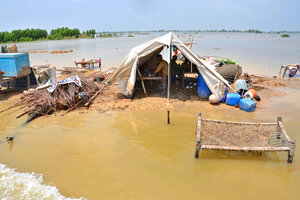Pakistan as climate bellwether
Responses to the country’s immense floods could provide models for other weather crises.

A family lives in a tent next to their demolished house, surrounded by floodwaters, in Pakistan's Baluchistan province, Aug. 29.
AP
The last time Pakistan faced catastrophic floods, in 2010, the international scientific community wasn’t yet prepared to draw a straight line to climate change. Silt deposits record that the Indus River menaced earlier civilizations, too. Nor had the world begun to grapple practically with how climate change would recast questions ranging from global cooperation to urban design.
All of that has now changed. A third of Pakistan is underwater – the result, scientists agree, of months of record-breaking heat that melted glaciers in the Himalayas and intensified the annual monsoon. The humanitarian impact is enormous. More than 1,100 people have died and tens of millions have been displaced. One town measured 67 inches of rain in a single day.
Yet amid the destruction, there are signs that humanity may be learning from overlapping crises to reject helplessness for resourcefulness, poor governance for accountability, and division for unity.
“I think what COVID-19 has done is make people realize the importance of global solutions to global risks and that what happens in one country can affect all countries,” argued John Scott, head of sustainability risk at Zurich Insurance Group, in a recent posting. “We need to harness our existing solutions and all our innovation ... to build climate resilience,” as societies did during the pandemic.
The Pakistan floods have begun to deliver a few dividends on these fronts. Longtime rival India has reopened closed trade corridors and may extend disaster aid to its neighbor for the first time since the ruling Bharatiya Janata Party came to power eight years ago. And the often-divisive politics in Pakistan may be on pause. Tahir Mehmood Ashrafi, chair of the Pakistan Ulema Council, has called on government leaders, Islamic scholars, and philanthropists to create an atmosphere of understanding and harmony.
One measure of progress may be better governance. A Gallup Poll found that 57% of Pakistanis supported the ouster in April of then-Prime Minister Imran Khan because “his government was unable to sort out inflation.” His successor, Shehbaz Sharif, faces even more pressure. Besides inflation, Pakistan has acute shortages of fuel, food, and health care supplies. A month before the monsoon came, it defaulted on a foreign loan for the first time. On Monday, the International Monetary Fund approved disbursement of $1.1 billion to Pakistan. To keep the loan, Mr. Sharif will have to address problems that have resulted in a cumulative debt burden of $24 billion.
“People always want cash after a disaster,” said Ayesha Siddiqi, a geographer at the University of Cambridge who studied Pakistan’s 2010 flood response, in an interview with Vox. What the state needs to learn, she said, is “how do we rehabilitate people ... so that they are not this vulnerable again?”
From Texas to China, places grappling with record floods, fires, or heat waves can follow how Pakistan copes with this disaster. It is on the front lines of both climate change and how governments can respond to it.

